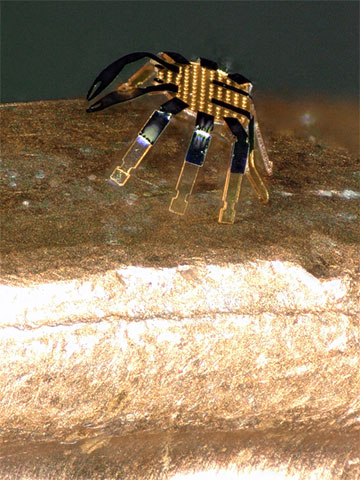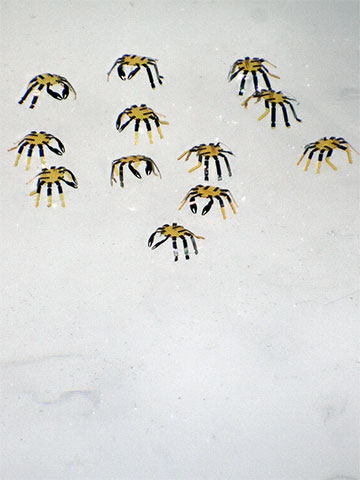
A close-up of the tiny crab robot, standing on the edge of a coin. [Image: Northwestern University]
An international team of engineers created and demonstrated a submillimeter robot that can walk, bend, twist, turn and jump via laser remote-control (Sci. Robot., doi: 10.1126/scirobotics.abn0602). Modeled after the peekytoe crab, the engineers say it is the world’s smallest remote-controlled robot.
The team believes its unique and simple “microbot”-manufacturing strategy could expand the function and performance of small-scale systems, bringing them a step closer to real-world applications. “You might imagine microrobots as agents to repair or assemble small structures or machines in industry,” the team lead, John A. Rogers of Northwestern University, USA, said in a press release, “or as surgical assistants to clear clogged arteries to stop internal bleeding or to eliminate cancerous tumors—all in minimally invasive procedures.”
Inspired by pop-up books
Unlike existing manufacturing methods for miniaturized robots, the team’s approach to submillimeter-robot design does not require complicated hardware, electricity or tethering to a remote-control device. The team’s new method, inspired by the 3D pictures in a pop-up book, uses a flexible substrate, a shape-memory alloy called nitinol, a semi-flexible polymer skeleton and external lasers for movement control.
To create their peekytoe-like robots, the engineers first transfer-print the robot’s nitinol joints and a structurally supportive polyimide (PI) skeleton onto a stretched-out silicone elastomer substrate. Next, they release the tension on the substrate, causing the silicone sheet to contract and the flat nitinol/PI-design to buckle and pop up, forming the 3D shape of a tiny crab. The engineers initiated the microbot’s movement by repeatedly heating and cooling the crab’s nitinol joints with a scanning laser, causing them to expand and contract.
In durability tests, Rogers and his colleagues found that the nitinol joints could undergo over 100,000 sequential heating–cooling transitions with a 520-nm scanning laser without losing stability.
A laser-powered crab crawl

An array of submillimeter, 3D peekytoe-crab robots. These microbots can be controlled with external scanning lasers. [Image: Northwestern University]
During proof-of-concept demonstrations, the engineers showed that they could control the direction of their walking robotic crabs with the direction and angle of the scanning laser. For example, when the leg joints were scanned with the laser from left to right, the microbot scuttled from right to left. And because the microbots are so small, joint heating and cooling happened quickly, allowing the robo-crabs to move at the relatively fast pace of half a body length per second.
The team could also create more complex movements, like jumping, turning, twisting and bending, by individually heating and cooling the crab’s joints.
The engineers demonstrated the microbots’ potential usefulness as wireless environmental sensors by outfitting them with light retroreflectors that triggered them into action when materials in their environment changed color due to variations in humidity or ultraviolet light.
In addition to the peekytoe-crab robot, the engineering team created microbots resembling baskets, circular helices and double-floor helices with the same materials and manufacturing method. “With these assembly techniques and materials concepts, we can build walking robots with almost any sizes or 3D shapes,” Rogers said.

